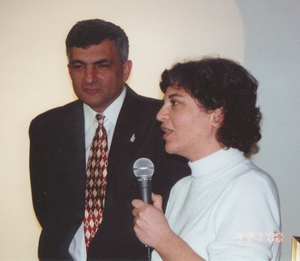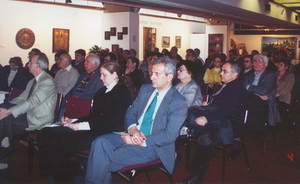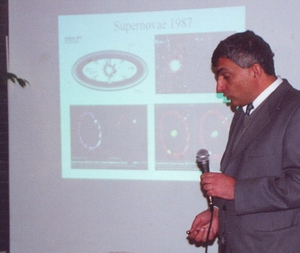Armenian Scientist Lectures At ALMA
 Anahid Yeremian, co-chair of SCACRD, introducing Prof. Chilingaryan |
On Palm Sunday, April 8, an audience of over 60 people gathered at ALMA in Watertown to listen to Professor Ashot Chilingaryan speak on "Armenian Science in a Global Environment." Prof. Chilingaryan is the head of the Cosmic Ray Division of the Yerevan Physics Institute. The Cosmic Ray Division (CRD) specializes in the study of high-energy particles created by solar activity and supernova explosions in outer space. High-energy physics is currently one of the most forward-looking and rigorous of all fields in the physical sciences. The CRD has remained at the cutting edge of research in this field owing to the dedication and talent of its staff and the observatory's unique location on Mount Aragats, near the famous village of Byurakan. Despite many advances in the study of particle physics, the highest-energy particles remain difficult to detect because their reactions when they strike matter are the least intense. Instead of ground-based accelerators, scientists must use the earth and atmosphere as detectors for these particles. The geographic location and altitude of Mount Aragats make it an ideal location for a cosmic ray observatory. Prof. Chilingaryan and the other CRD staff study cosmic rays for what they can tell us about the structure and evolution of the universe, but their work also has more immediate practical applications.
 The audience at the Armenian Cultural Center in Alma, MA listening attentively to Prof. Chilingaryan. |
Prof. Chilingaryan spent the first days of Easter week in the Boston area in order to speak at the International Science and Technology Center's conference in Newton, where he gave a lecture on "New Computation Method for Genome-Wide Expression Analysis with cDNA Microarrays." The CRD has developed software for the analysis and comparison of gene sequences, which has been used by the Huntsman Cancer Institute in Utah. Prof. Chilingaryan visited the Huntsman Institute prior to his stay in Boston. The gene sequencing software grows out of the data analysis techniques the CRD has developed in predicting the emission of particles from space, a specialty which has practical applications in its own right. Solar storms and eruptions cause electromagnetic disturbances on earth which can potentially disrupt earth-based power distribution and communications systems as well as damaging satellites and other space equipment. Predicting the storms can allow the operators of these systems to take protective measures. Thirdly, the CRD has developed a Neural Network software toolkit as another offshoot of its development of data analysis techniques; this software also has potential for wide-ranging applications. Prof. Chilingaryan described all of these innovations and their potential for commercial applications.
 Prof. Chilingaryan explaining how Armenia's Cosmic Ray Division explores the mysteries of our universe. |
The CRD has survived a difficult transitional period in the last year. While funding from international partnerships pays for most of their expenses, they lack funding for certain key overhead expenses such as actual maintenance, supplies, and some salaries. The CRD Support Committee was formed in 2000 by Stanford physicist Anahid Yeremian and consists of Yeremian, Joseph Dagdigian of Avici Systems in Billerica and Tanya Bresinsky of MIT. With the invaluable help of the Armenian Engineers and Scientists of America (AESA) and of the Armenian National Science and Education Fund (ANSEF), enough money was raised in 2000 to keep the CRD open and providing its research partners around the world with valuable data. At the ALMA lecture, Dagdigian was introduced by George Bagdasarian, President of the New England branch of AESA. Together with AESA and ANSEF, Dagdigian thanked ALMA, the Lousintak chapter of the Lowell ARS, and the Merrimack Valley ANC. Roy Zohrabian of ATN Microwaves also made a few brief remarks on the urgency of the situation in Armenia and the need for Diasporan support. In keeping with April's meaning for all Armenians, the overall impression of the meeting was one of urgency combined with a sense of renewal.